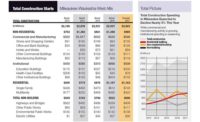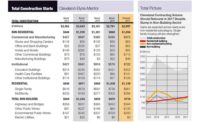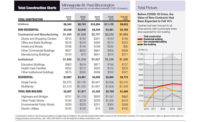A Midwest Record $43.5B in Construction Starts in 2019

Fiat Chrysler’s Mack Avenue Assembly Complex is the company’s first new assembly plant in Detroit in nearly 30 years. It is scheduled for completion by the end of the year.
PHOTO COURTESY OF BARTON MALOW
The transportation sector led the way as the value of new projects to break ground in the Midwest in 2019 rose to record-setting levels in ENR Midwest’s Top Starts list. The cost of the top 100 projects totaled an all-time high of $43.5 billion. That’s an increase of 35% over the $30.9 billion reported in 2018.
The Chicago Transit Authority’s Red/Purple Line Modernization Phase 1 tops the list at a cost of $2.1 billion. The project broke ground in October with major construction slated to begin at the end of 2020 or early 2021. Immediately following is the $1.9-billion Kansas City International Airport single terminal.
The top seven projects each hit the $1-billion level. The 1.2-GW Natural Gas-Fired Combined Cycle Facility in Elwood, Ill., was ranked No. 4. The facility is the list’s first indicator that the energy sector retained its muscle, with 32 power plants breaking ground across 10 states.
The starts in ENR’s 11-state Midwest region were higher at the bottom of the list as well as at the top. Project costs had dipped below the $100-million level at No. 89 in 2018’s Top Starts list. In 2019, only three of the largest 100 starts were even below the $150-million mark, and No. 100 was a $137-million high school in Ames, Iowa. To better illustrate the breadth of projects across Iowa, Illinois, Indiana, Kansas, Kentucky, Michigan, Minnesota, Missouri, Nebraska, Ohio and Wisconsin, the data has also been broken down by state and project type for the first time this year.
|
Related Link |
Among cities, Chicago led the way with 11 projects on the list. Project types across the region ran the gamut from airline terminals to pipelines to apartments and condominium towers.
The Red/Purple Line Modernization project from the Chicago Transit Authority is a rebuild of a 9.6-mile stretch of track, much of it built in 1924, designed to handle the massive amount of riders along Chicago’s far North Side. It is meant to last for at least the next 60 years. Phase 1 will completely rebuild four CTA stations and all tracks and support structures more than a mile adjacent to the stations. A bypass of the Red and Purple line trains, which requires a new overhead track held up by a straddle-bent for Brown Line trains to ride up and over the existing Red and Purple line tracks, is also under construction.
Federal grants from the U.S. Department of Transportation provided $1.07 billion toward the project, with another $622 million coming from transit TIF funds from the city of Chicago and CTA financing.
After a protracted procurement process that included a public vote and lots of city council intrigue, Kansas City’s $1.9-billion single terminal airport project, designed by Skidmore Owings & Merrill, is finally underway. A 6,500-space, seven-story parking garage is being delivered via design-build by local contractor JE Dunn Construction. Work also started on the terminal, with the joint venture contractor Clark, Weitz and Clarkson breaking ground on the new facility, with completion expected by 2023. It’s being delivered by a public-private partnership with SOM, the three contractors and Bethesda, Md.-based developer Edgemoor Infrastructure & Real Estate.
Data centers, solar and natural gas energy production maintained their high level of regional investment compared to previous Top Starts lists. Owners such as DTE Energy, Facebook, Microsoft, Amazon and MidAmerican Energy were again fixtures of on the list. Amazon branched out from data center investment and added two starts totaling nearly $1.5 billion for its Amazon Prime Air Hub near the Cincinnati Airport in Covington, Ky. The facility will be used entirely for Amazon’s air cargo business.
“This amount of work has been so great for metro Detroit, and we made sure to utilize all our Michigan and U.S. resources.”
– Rich Giffin, Vice President of Sales, Giffin
The manufacturing sector reported an increase in projects. Fiat Chrysler Automobiles (FCA) is building the company’s first new assembly plant in Detroit in nearly 30 years. The plant is on a fast track, going from its February 2019 announcement to the test paint of its first vehicle set for just 18 months later and full production planned before the end of the year. The $1.6-billion project—renamed in February the Detroit Assembly Complex Mack (DACM)—transforms FCA’s old Mack Avenue Engine Complex into an assembly plant focusing on Jeep and Jeep Grand Cherokee SUVs.
Local architecture firm Ghafari, known for its manufacturing expertise, is designing the plant and is the engineer of record for DACM, while local contractor Barton Malow is on board as the general contractor with Walbridge Aldinger Co. as construction manager. Barton Malow is working with Auburn Hills-based Giffin Inc. as its turnkey paint shop supplier on the project’s 685,000-sq-ft paint shop, a large component of the assembly plant.
Rich Giffin, vice president of sales at Giffin, says the biggest challenge on the project is the tight timeline.
“It’s never been done in the industry on this timeline,” Giffin says. “Knowing we’ve got to get this off the ground, we were looking at each other like we passed insanity months ago. But this amount of work has been so great for metro Detroit, and we made sure to utilize all our Michigan and U.S. resources.”
Other top manufacturing starts include a $700-million expansion to the North Star BlueScope Steel Manufacturing Facility in Delta, Ohio. The company, which sells steel products across a 300-mile radius in northwest Ohio and southern Michigan, said the upgrade will add 1.04 million tons of steel to the existing 2.5 million tons the factory annually produces. Construction kicked off in August and is expected to be fully operational by late 2021.
The $500-million Green Bay Packaging Paper Mill, scheduled to open in the first quarter of 2021, and the $200 million Digi-Key Electronics Distribution Center in Thief River Falls, Minn., spread the manufacturing wealth throughout the Great Lakes region.
Alan Blanchette, project director for Barton Malow, says projects such as DACM show the record-setting year may not be an aberration.
“If you look at, for example, electronic vehicles, it shows a strength for upcoming years,” Blanchette says. “I look forward to the competition stepping up as well. Our industry remains strong.”



